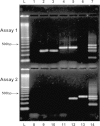A multiplex nested PCR for the detection and identification of Candida species in blood samples of critically ill paediatric patients
- PMID: 25047415
- PMCID: PMC4223582
- DOI: 10.1186/1471-2334-14-406
A multiplex nested PCR for the detection and identification of Candida species in blood samples of critically ill paediatric patients
Abstract
Background: Nosocomial candidaemia is associated with high mortality rates in critically ill paediatric patients; thus, the early detection and identification of the infectious agent is crucial for successful medical intervention. The PCR-based techniques have significantly increased the detection of Candida species in bloodstream infections. In this study, a multiplex nested PCR approach was developed for candidaemia detection in neonatal and paediatric intensive care patients.
Methods: DNA samples from the blood of 54 neonates and children hospitalised in intensive care units with suspected candidaemia were evaluated by multiplex nested PCR with specific primers designed to identify seven Candida species, and the results were compared with those obtained from blood cultures.
Results: The multiplex nested PCR had a detection limit of four Candida genomes/mL of blood for all Candida species. Blood cultures were positive in 14.8% of patients, whereas the multiplex nested PCR was positive in 24.0% of patients, including all culture-positive patients. The results obtained with the molecular technique were available within 24 hours, and the assay was able to identify Candida species with 100% of concordance with blood cultures. Additionally, the multiplex nested PCR detected dual candidaemia in three patients.
Conclusions: Our proposed PCR method may represent an effective tool for the detection and identification of Candida species in the context of candidaemia diagnosis in children, showing highly sensitive detection and the ability to identify the major species involved in this infection.
Figures

References
-
- Arendrup MC. Epidemiology of invasive candidiasis. Curr Opin Crit Care. 2010;16(5):445–452. - PubMed
-
- Benjamin DK Jr, Poole C, Steinbach WJ, Rowen JL, Walsh TJ. Neonatal candidemia and end-organ damage: a critical appraisal of the literature using meta-analytic techniques. Pediatrics. 2003;112(3 Pt1):634–640. - PubMed
-
- Wisplinghoff H, Bischoff T, Tallent SM, Seifert H, Wenzel RP, Edmond MB. Nosocomial bloodstream infections in US hospitals: analysis of 24,179 cases from a prospective nationwide surveillance study. Clin Infect Dis. 2004;39:309–317. - PubMed
Publication types
MeSH terms
Substances
LinkOut - more resources
Full Text Sources
Other Literature Sources

